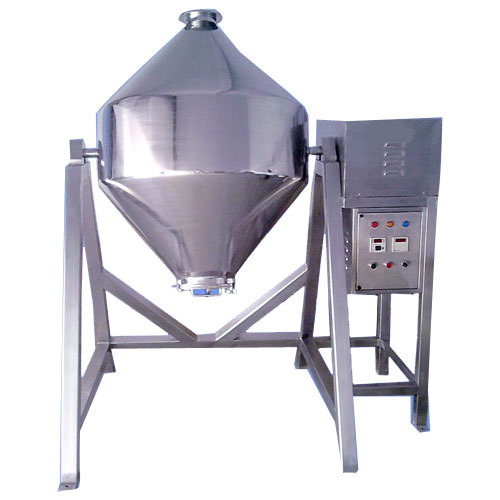Rotary double cone vacuum dryers are suitable for drying & mixing powder (raw materials), pharmaceutical materials, crystalline products, insecticides, pesticides, food products & also for heat sensitive products. The equipment can also be used as rotary evaporator
Raw material is charged in batches & is subjected to indirect heating while at the same time undergoing rotary motion of the cone assembly. The conical shape of the dryer ensures efficient circulation of hot liquid heating media. Drying takes place when heat flows from outer cone through a jacket, and vacuum is applied in the inner cone. The drying operation is based on the principle that water or other volatile product moves from a zone of low pressure. This is accomplished by warming the product to be dried to raise the vapour pressure of the absorbed or free liquid by vacuum or by sweeping it with Air or Nitrogen current. Thus the essential conditions for effective drying are achieved by uniform heat transfer throughout the batch and rapid removal of the vapour. The vacuum is applied gradually with PLC control by throttling.
Features
- Low temperature drying under vacuum
- Higher Thermal Efficiency
- Specially designed micro air-filter can be provided on
receiver while breaking vacuum for safety operation - Nitrogen purging system is available optionally for mechanical seal as well as for cleaning
filter - Specially designed S.S. Rotary union is provided for hot water or steam at inlet & outlet
- Lowest energy consumption compared to any other batch type dryer due to higher differential temperatures
Advantages:
- Reduces drying time.
- Total contained process, dust control.
- Efficient Charging and Discharge.
- Choppers (Lump Breaker) give lump free product.
- Easy Open-able charging port.
- Eliminates need for re-drying of lumps.
- Handling and exposure of final product is avoided.
- Gives uniformity size dry product.
- System can process crystalline or amorphous powders which are prone for lumps.
- Easy to clean internal surface, thus ensuring purity of product.
- Optimum and Continuous vacuum maintenance during process.
- Uniform material shuffling over the heated contact surface of the cone.


